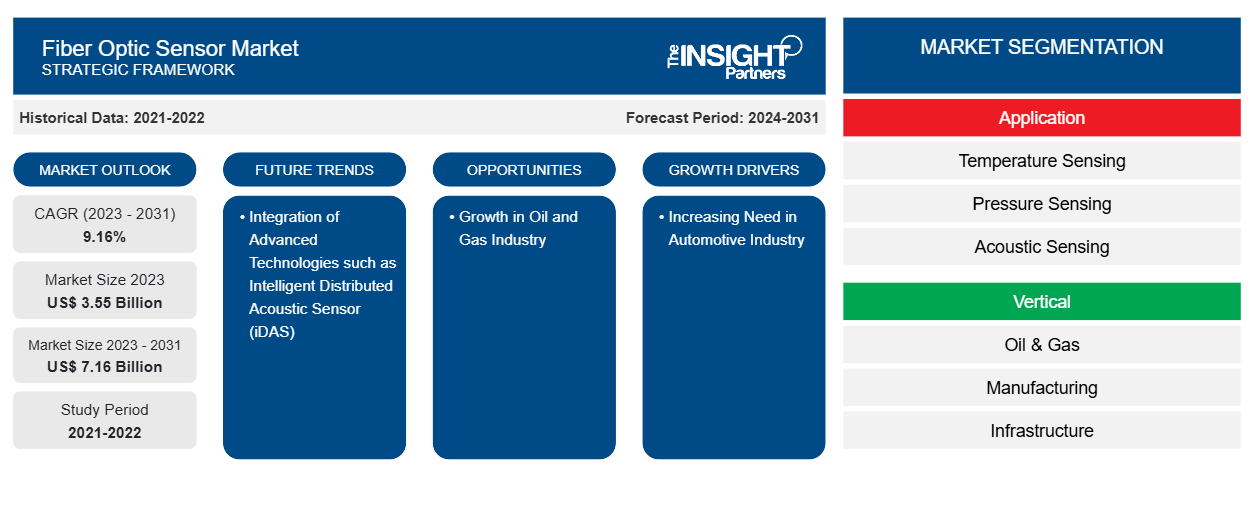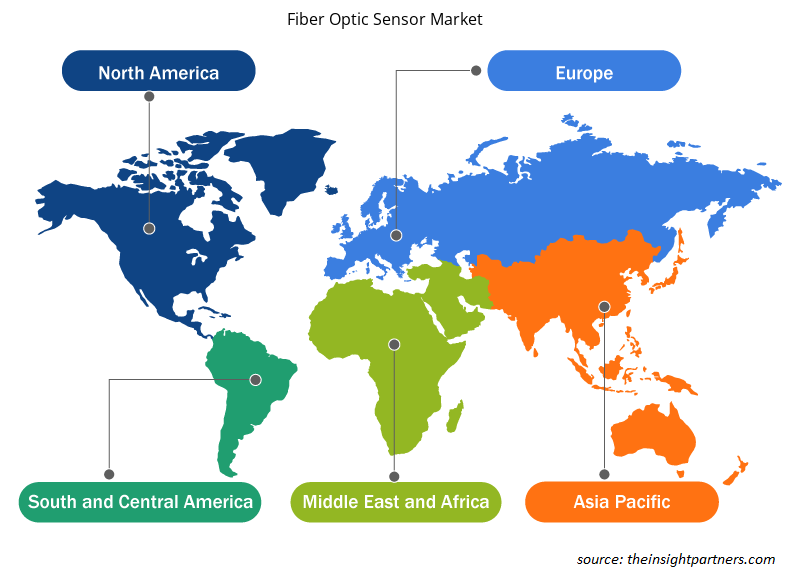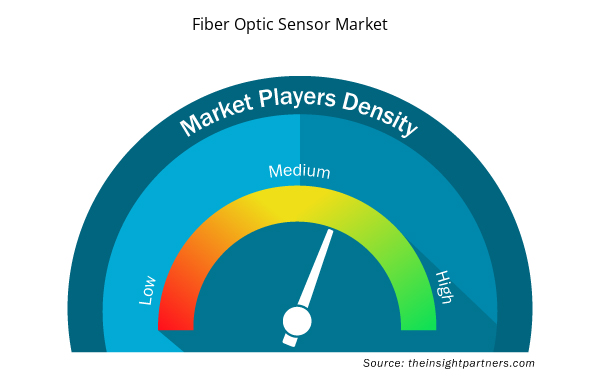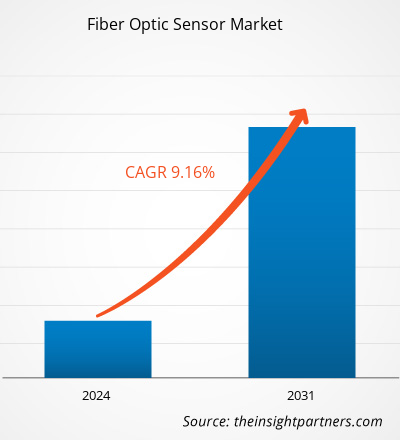The fiber optic sensor market size is projected to reach US$ 7.16 billion by 2031 from US$ 3.55 billion in 2023. The market is expected to register a CAGR of 9.16% during 2023–2031. Integration of advanced technologies such as intelligent Distributed Acoustic Sensor (iDAS) is likely to remain a key trend in the market.
Fiber Optic Sensor Market Analysis
Fiber optic sensing technology is currently utilized in a range of industries, such as automotive, healthcare, aerospace, civil engineering, manufacturing, and energy. Fiber optic sensors are affordable, light, durable, immune to electromagnetic interference, and able to function in challenging environments. Fiber optic sensors can measure over 60 parameters, such as strain, temperature, internal and applied loads, deflection, and liquid level, enabling various applications. Fiber optic sensors can be placed near significant EMI sources and structures at risk of lightning strikes, unlike conventional electrical sensors. Therefore, the demand for fiber optic sensors is projected to increase in the coming years, particularly in situations where traditional electrical sensors struggle due to harsh weather conditions.
Fiber Optic Sensor Market Overview
Optical fiber sensing technology is utilized for measuring various parameters such as chemical changes, strain, temperature, pressure, electric and magnetic fields, displacement, rotation, radiation, liquid level, flow, light intensity, and vibrations. Additionally, they can be employed in high-temperature, high-voltage, or corrosive environments and are competent in remote sensing. Furthermore, they find applications in various sectors, including oil & gas, manufacturing, infrastructure, power and utilities, automotive, and healthcare. These sensors are not only capable of linear and seamless sensing, but they also function as sensors in communication applications without the need for electricity.
Customize This Report To Suit Your Requirement
You will get customization on any report - free of charge - including parts of this report, or country-level analysis, Excel Data pack, as well as avail great offers and discounts for start-ups & universities
Fiber Optic Sensor Market: Strategic Insights

- Get Top Key Market Trends of this report.This FREE sample will include data analysis, ranging from market trends to estimates and forecasts.
Customize This Report To Suit Your Requirement
You will get customization on any report - free of charge - including parts of this report, or country-level analysis, Excel Data pack, as well as avail great offers and discounts for start-ups & universities
Fiber Optic Sensor Market: Strategic Insights

- Get Top Key Market Trends of this report.This FREE sample will include data analysis, ranging from market trends to estimates and forecasts.
Fiber Optic Sensor Market Drivers and Opportunities
Increasing Need in the Automotive Industry to Favor Market Growth
The fiber carries cold light, providing a secure option compared to sealed beam or halogen lighting. Fiber optic sensors are utilized in lighting applications within the automotive industry. In addition to the safety benefits, the light source is conveniently located and allows for more creative design possibilities. The sensors are utilized in cars for onboard safety features, including airbag operation, traction control devices, and safety systems. The use of fiber optics also enables the division of light source and destination, offering advanced lighting choices that require less space, making them ideal for challenging and limited access areas. Additionally, the increasing disposable incomes, particularly in emerging countries in APAC, stimulate the sales of passenger vehicles, which in turn will drive the usage of fiber optic sensors. Therefore, the increasing annual sales in the automotive industry play a crucial role in driving the expansion of the fiber optic sensor market.
Growth in Oil and Gas Industry
The escalating power and energy industry drives the increasing demand for the fiber optic sensor market. This is due to the essential role of optic fiber sensors in surviving high temperatures, a crucial factor in the oil and gas industries. The booming oil and gas industry in the upcoming years is further fueling the demand for fiber optic sensors, as their extraction procedures often involve working at high temperatures unsuitable for human intervention. In these situations, the fiber optic sensor stands as a suitable solution.
Fiber Optic Sensor Market Report Segmentation Analysis
Key segments that contributed to the derivation of the fiber optic sensor market analysis are application and vertical.
- Based on application, the market is segmented into temperature sensing, pressure sensing, acoustic sensing, strain sensing, and others. The temperature sensing segment held a significant market share in 2023.
- In terms of vertical, the market is divided into oil and gas, manufacturing, infrastructure, power and utilities, and others. The oil and gas segment held a substantial share of the market in 2023.
Fiber Optic Sensor Market Share Analysis by Geography
The geographic scope of the fiber optic sensor market report is mainly divided into five regions: North America, Asia Pacific, Europe, Middle East & Africa, and South & Central America.
The North American market is growing significantly owing to the advancement of fiber-based sensors in healthcare and automotive industries. Moreover, the major companies are prioritizing expanding their distribution channels to increase market expansion. Europe is expected to experience consistent growth due to the ongoing need for precise fiber optic temperature sensors in industrial settings. In addition, the steady growth in European countries is being supported by the presence of manufacturers such as Proximion AB, Calex Electronics Limited, Scaime, Althen sensors & control, and others.
Fiber Optic Sensor Market Regional Insights
The regional trends and factors influencing the Fiber Optic Sensor Market throughout the forecast period have been thoroughly explained by the analysts at Insight Partners. This section also discusses Fiber Optic Sensor Market segments and geography across North America, Europe, Asia Pacific, Middle East and Africa, and South and Central America.

- Get the Regional Specific Data for Fiber Optic Sensor Market
Fiber Optic Sensor Market Report Scope
| Report Attribute | Details |
|---|---|
| Market size in 2023 | US$ 3.55 Billion |
| Market Size by 2031 | US$ 7.16 Billion |
| Global CAGR (2023 - 2031) | 9.16% |
| Historical Data | 2021-2022 |
| Forecast period | 2024-2031 |
| Segments Covered |
By Application
|
| Regions and Countries Covered | North America
|
| Market leaders and key company profiles |
Fiber Optic Sensor Market Players Density: Understanding Its Impact on Business Dynamics
The Fiber Optic Sensor Market market is growing rapidly, driven by increasing end-user demand due to factors such as evolving consumer preferences, technological advancements, and greater awareness of the product's benefits. As demand rises, businesses are expanding their offerings, innovating to meet consumer needs, and capitalizing on emerging trends, which further fuels market growth.
Market players density refers to the distribution of firms or companies operating within a particular market or industry. It indicates how many competitors (market players) are present in a given market space relative to its size or total market value.
Major Companies operating in the Fiber Optic Sensor Market are:
- AOMS Technologies
- Davidson Instruments
- Omnisens SA
- Solifos AG
- Baumer Holding AG
- Keyence Corporation
Disclaimer: The companies listed above are not ranked in any particular order.

- Get the Fiber Optic Sensor Market top key players overview
Fiber Optic Sensor Market News and Recent Developments
The fiber optic sensor market is evaluated by gathering qualitative and quantitative data post primary and secondary research, which includes important corporate publications, association data, and databases. A few of the developments in the fiber optic sensor market are listed below:
- Luna Innovations acquired Silixa on December 21, 2023. Recognized as an award-winning innovator, Silixa has developed a reputation for revolutionizing multiple industries. Offering a distinct portfolio of distributed sensing solutions shaped by 15 years of pioneering research and application, delivering end-to-end solutions that enable temperature, strain, and acoustic measurements at the highest fidelity – even in the most hostile settings. This acquisition, paired with Luna’s already robust fiber optic sensing catalog, strengthens Luna’s vision of enabling the future with fiber.
(Source: Luna, Company Website, December 2023)
Fiber Optic Sensor Market Report Coverage and Deliverables
The “Fiber Optic Sensor Market Size and Forecast (2021–2031)” report provides a detailed analysis of the market covering below areas:
- Fiber optic sensor market size and forecast at global, regional, and country levels for all the key market segments covered under the scope
- Fiber optic sensor market trends as well as market dynamics such as drivers, restraints, and key opportunities
- Detailed PEST/Porter’s Five Forces and SWOT analysis
- Fiber optic sensor market analysis covering key market trends, global and regional framework, major players, regulations, and recent market developments
- Industry landscape and competition analysis covering market concentration, heat map analysis, prominent players, and recent developments for the fiber optic sensor market
- Detailed company profiles
- Historical Analysis (2 Years), Base Year, Forecast (7 Years) with CAGR
- PEST and SWOT Analysis
- Market Size Value / Volume - Global, Regional, Country
- Industry and Competitive Landscape
- Excel Dataset



Report Coverage
Revenue forecast, Company Analysis, Industry landscape, Growth factors, and Trends

Segment Covered
Application, and Vertical

Regional Scope
North America, Europe, Asia Pacific, Middle East & Africa, South & Central America

Country Scope
Argentina, Australia, Brazil, Canada, China, France, Germany, India, Italy, Japan, Mexico, Russian Federation, Saudi Arabia, South Africa, South Korea, United Arab Emirates, United Kingdom, United States
Frequently Asked Questions
The market is anticipated to record a CAGR of 9.16% during 2023–2031.
The market is expected to reach a value of US$ 7.16 billion by 2031.
AOMS Technologies, Davidson Instruments, Omnisens SA, Solifos AG, Baumer Holding AG, Keyence Corporation, OMRON Corporation, Luna Innovations Inc, SICK AG, and Yokogawa Electric Corporation are major players in the market.
Integration of advanced technologies such as intelligent Distributed Acoustic Sensor (iDAS) are key trends in the market.
Increasing needs in the automotive industry and increasing investments in R&D activities are driving the market.

 Get Free Sample For
Get Free Sample For